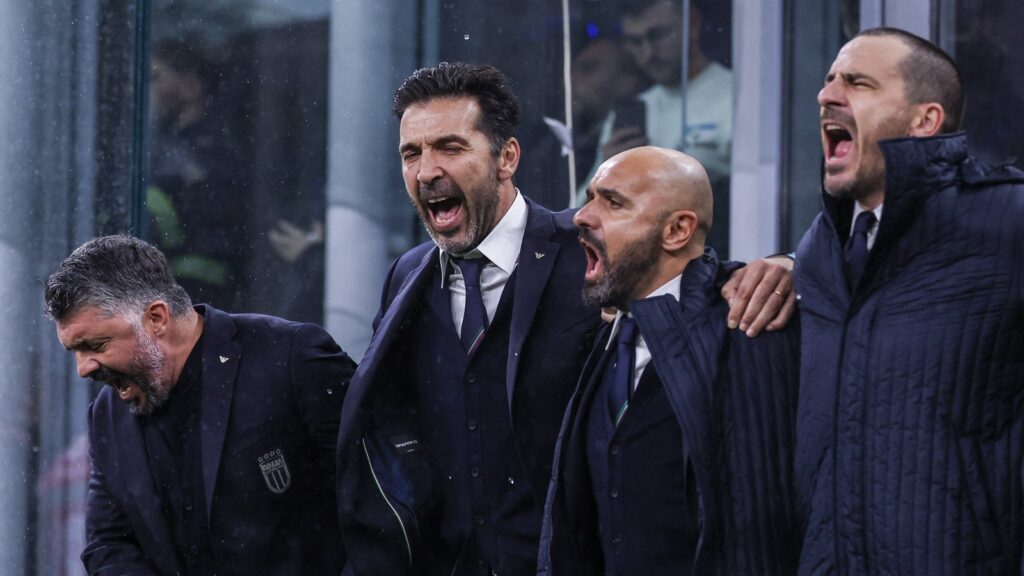Italy once again faces a crucial crossroads: the playoffs for the 2026 World Cup represent the Azzurri‘s last chance to secure their spot at the tournament. After a challenging group, Gennaro Gattuso‘s national team faces two one-off matches in March. But before their opponents are known, every scenario is still being deciphered: the draw in Zurich, scheduled for tomorrow, November 20, will decide the Italians’ fate.
The Play-Off Mechanism
The European qualification system provides for 16 teams in the playoffs: 12 group runners-up plus four teams “repeated” through the Nations League.
These teams will be divided into four mini-paths, each with single-leg semifinals and finals.
According to the draw, the Italian semifinal should be played at home thanks to Italy’s favorable ranking, which allows them to be in Pot 1.
The dates already set are March 26, 2026, for the “progress” play-off (semifinal) and March 31 for the final.
Where Italy could play
One of the most sensitive issues is the choice of stadium for the semifinal match. One of the most concrete possibilities is the Gewiss Stadium in Bergamo, a venue that could offer the right atmosphere without falling under the “symbolic pressure of San Siro.”
For the final, the Stadio Olimpico in Rome is being discussed, although nothing is yet definitive: the venue will likely be decided by the draw.
This choice reflects a strategy: to minimize taboos (such as the media “weight” of Milan) and maximize the home crowd, albeit in a different context than the major historic stadiums.
Potential opponents: scenarios and pitfalls
The draw is still ahead of us, but the potential rivals are now fairly clear. Italy could face one of the Nations League’s “repeated” teams in the semifinals, such as Sweden, Northern Ireland, Wales, or Romania.
If they were to reach the final, the options become even more varied: among the candidates are nations rich in history or technically dangerous, such as the Czech Republic, Scotland, or even North Macedonia.
There’s also a very evocative “historical” theme: some of these nations have, as we know, already denied Italy access to the World Cup in the past. Sweden, for example, was responsible for Italy’s elimination in 2017, while North Macedonia was decisive in the 2022 playoffs.
This combination of tactical and emotional risk makes the draw not only a pivotal moment from a sporting point of view, but also a symbolic one.
A look at the present
Gennaro Gattuso, at the helm of the national team, has named a squad that mixes certainties with new arrivals: among those called up for the final matches, young goalkeeper Elia Caprile stands out, along with the return of veterans like Cristante and Mancini, and the confirmation of the young Pio Esposito, who, after his goal against Norway, may now be a much more familiar figure, even to Erling Haaland, who in the pre-match press conference had confessed he wasn’t familiar with the Nerazzurri striker.
This selection aims to strike a balance: on the one hand, experience and physicality; on the other, freshness and dynamism. For the playoffs, it will be essential for Gattuso to challenge his players mentally, too, because the stakes are so high.
Italy approaches these play-offs with a significant advantage, but cannot afford distractions: every detail, from the opponents’ draw to the match venue, can significantly impact their progress.
The Psychological Impact of the Playoffs
It’s not just a technical issue: returning to the World Cup after an absence (or after painful experiences in the playoffs) means facing a significant psychological impact. The potential opponents evoke uncomfortable memories, and the pressure on the home pitch will be enormous.
On the other hand, the opportunity to play a semifinal “at home” could turn into a decisive advantage, if managed well. The Gewiss Stadium, if confirmed, could become the scene of a rebirth, rather than a grand media spectacle.
Why tomorrow’s draw, November 20th, is so crucial
Tomorrow evening’s draw in Zurich will become the key moment in determining the Azzurri’s fate. Not only because it will determine their opponent, but also because it will define the path—whether “easier” or more arduous—toward the World Cup. It’s the moment when the Azzurri’s future can take concrete shape.
A test of maturity for Italy
We’re heading into a decisive March, aware that talent isn’t enough: you need a cool head, a beating heart, and a lot of determination. The playoffs are no longer a passing variable, but a test of maturity.
Gattuso must prepare the team not only technically but also emotionally, because victory in the playoffs could mark Italy’s return to the top ranks of world football. But if the draw goes badly, then every decision, pitch, opponent, and attitude will weigh doubly.
We’ll soon find out what we’re made of!
